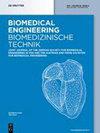震颤患者运动模式的实时分类
IF 1.8
4区 医学
Q4 ENGINEERING, BIOMEDICAL
引用次数: 0
摘要
摘要在对震颤患者的诊断过程中,经常出现误诊。因此,需要现有的分析震颤的技术方法来更有效地区分不同的疾病。为此,开发了一种系统,可以实时对测量到的震颤信号进行分类。为了实现这一目标,561名受试者在不同的手位下进行了手部震颤测量。在检查过程中记录加速和表面肌电图。本研究考虑了帕金森病、原发性震颤和生理性震颤患者的数据。在第一个信号分析中,进行特征提取,并检查结果特征的判别值。第二步,开发了基于不同模式识别技术的三种分类模型,根据受试者的震颤类型对其进行分类。用训练好的决策树对三种震颤类型进行分类,相对诊断准确率为83.14%。神经网络达到了84.24%,两种分类器的组合产生了85.76%的相对诊断准确率。该方法是一种很有前途的方法,它涉及了更多的记录时间序列特征,提高了判别值。本文章由计算机程序翻译,如有差异,请以英文原文为准。
Real-time classification of movement patterns of tremor patients
Abstract The process of diagnosing tremor patients often leads to misdiagnoses. Therefore, existing technical methods for analysing tremor are needed to more effectively distinguish between different diseases. For this purpose, a system has been developed that classifies measured tremor signals in real time. To achieve this, the hand tremor of 561 subjects has been measured in different hand positions. Acceleration and surface electromyography are recorded during the examination. For this study, data from subjects with Parkinson’s Disease, Essential Tremor, and physiological tremor are considered. In a first signal analysis feature extraction is performed, and the resulting features are examined for their discriminative value. In a second step, three classification models based on different pattern recognition techniques are developed to classify the subjects with respect to their tremor type. With a trained decision tree, the three tremor types can be classified with a relative diagnostic accuracy of 83.14%. A neural network achieves 84.24% and the combination of both classifiers yields a relative diagnostic accuracy of 85.76%. The approach is promising and involving more features of the recorded time series will improve the discriminative value.
求助全文
通过发布文献求助,成功后即可免费获取论文全文。
去求助
来源期刊
CiteScore
3.50
自引率
5.90%
发文量
58
审稿时长
2-3 weeks
期刊介绍:
Biomedical Engineering / Biomedizinische Technik (BMT) is a high-quality forum for the exchange of knowledge in the fields of biomedical engineering, medical information technology and biotechnology/bioengineering. As an established journal with a tradition of more than 60 years, BMT addresses engineers, natural scientists, and clinicians working in research, industry, or clinical practice.

 求助内容:
求助内容: 应助结果提醒方式:
应助结果提醒方式:


